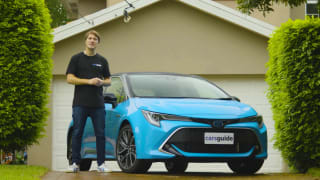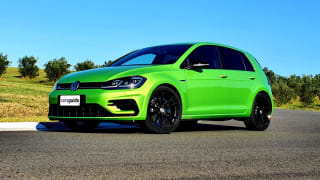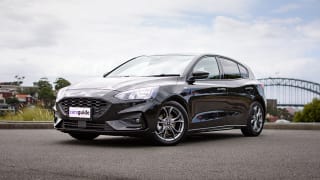The X20 Astina auto starts from $41,590 before on-road costs.
That’s around $4000 more than the vaunted new Volkswagen Golf R-Line ($37,450), $5000 more than the spirited Hyundai i30 N-Line Premium ($36,220), $7000 more than the frugal Toyota Corolla ZR Hybrid ($34,695), $8000 more than the roomy Kia Cerato GT ($33,690) and nearly $10K more than the dynamic Ford Focus ST-Line.
Or, if you like, the Mazda is $6000 under the now-front-drive BMW 118i, $5000 less than the ultra-cool Mini Cooper S Clubman and $3500 cheaper than the slick Mercedes-Benz A180.
It’s in the no-man’s land of beyond mainstream and aspirational, and about three quarters of the way to premium. In fact, a runout (old-shape) MY20 Audi A3 Sportback in mid-range 35TFSI S Sportback spec is nearly a grand cheaper while the X20 Astina is lineball with the geriatric Lexus CT200 Luxury.
So, how does the Mazda respond to such observations?
Firstly, being the flagship grade, the X20 Astina’s features list is extensive.
The full suite of safety gear includes seven airbags, front and rear autonomous emergency braking with pedestrian and cycle detection, Blind Spot Monitoring, Lane Departure Warning, Lane-keep Assist, driver monitor, Forward Obstruction Warning, Rear and Front Cross Traffic Alert, Secondary Collision Reduction (that automatically keeps the brakes applied to stop further impacts), auto high beam control for the adaptive headlights, breakaway pedals, adaptive cruise control with full stop/go functionality and cruising/traffic support, parking sensors front/rear, 360-degree round-view monitor, reverse camera, traffic sign recognition and tyre-pressure monitors.
On the luxury side, there’s leather upholstery or leather-looking material everywhere including over the dashboard, heated front seats, a powered driver’s seat with position memory, heated leather steering wheel, windscreen-reflected full-colour head-up display, satellite navigation, auto tilt/folding/heated/dimming mirrors, sunroof, dual-zone climate control, Apple CarPlay/Android Auto, Bose premium audio with amplifier and 12 speakers, Bluetooth phone/audio connectivity, digital radio, keyless entry/start and polished 18-inch alloys.

So why is the top Mazda3 so expensive?
Mazda argues that what the X20 offers that the others don’t is its unique SkyActiv X technology. Confusingly branded ‘hybrid’, it is in fact much like a normal 2.0-litre petrol engine with diesel-like compressed ignition that promises significantly reduced consumption; there’s no electric motor, just a belt-driven integrated starter generator (ISG) and a 24-volt lithium-ion battery that captures otherwise spent energy during deceleration to power the ISG; basically it’s a hybrid that’s milder than a gay courting scene modified for viewing on a Middle Eastern airliner.
The thing is, Skyactiv-X is a hefty $3000 option over the conventionally-powered G25 Astina, which uses a 139kW/252Nm 2.5-litre four-cylinder petrol engine that is both more powerful and torquier than our X20 Astina’s 132kW/224Nm 2.0-litre SkyActiv X unit. Where you might find a benefit is in the latter’s official 5.5L/100km combined fuel consumption average, against the former’s 6.6L/100km. You’d hope so anyway, as a way of making a return on investment.
Note that its most powerful aforementioned rivals (rorty i30 N-Line and Cerato GT) deliver 150kW while the most frugal one (sluggish Corolla ZR Hybrid) returns just 4.2L/100km.
Except for the pesky (and woefully underrated) Focus and its 132kW output and 6.4L/100km economy, on numbers alone, the X20 Astina’s efficiency promises look… promising.




































